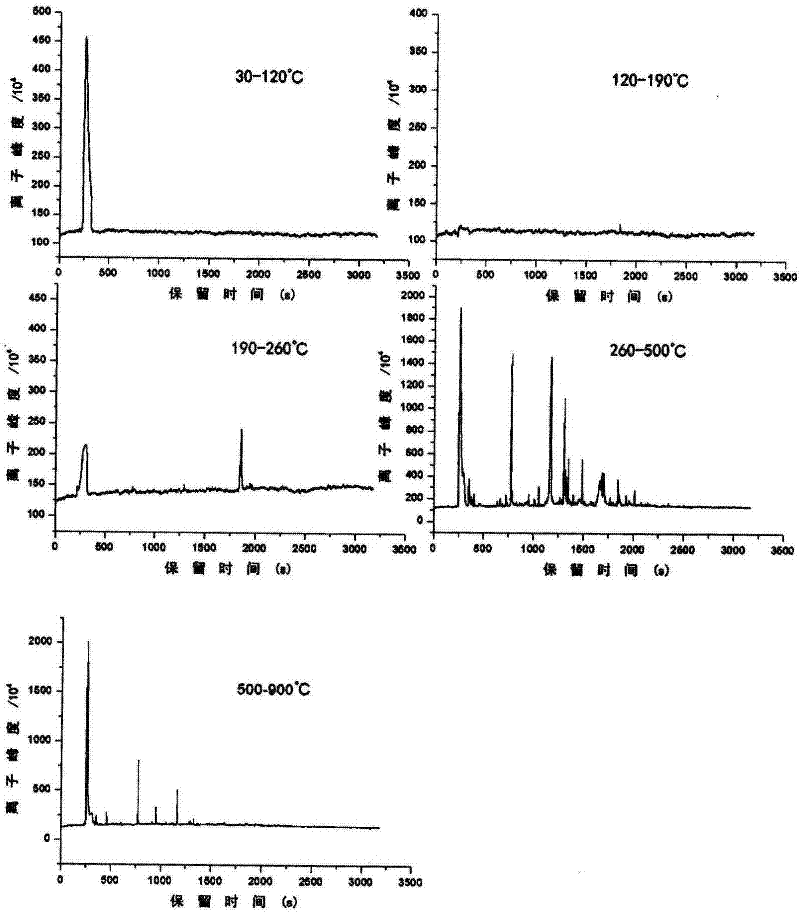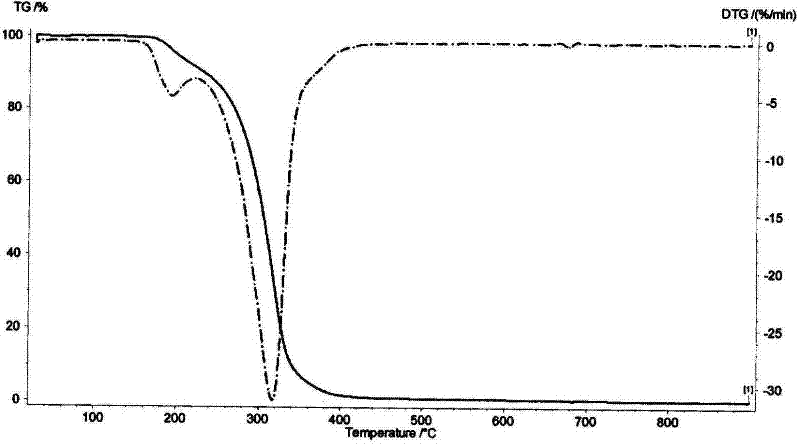Gradient cracking method for researching compound cracking process
A compound and compound technology, applied in the field of compound analysis, can solve problems such as complex products, unfavorable compound cracking process, etc.
- Summary
- Abstract
- Description
- Claims
- Application Information
AI Technical Summary
Problems solved by technology
Method used
Image
Examples
example 1
[0021] Example 1 Cracking of chlorogenic acid
[0022] Weigh about 10 mg of chlorogenic acid (purity >99%) into an alumina crucible, and raise the temperature from 30 °C to 900 °C at a heating rate of 5 °C / min under a nitrogen flow rate of 40 mL / min. The thermogravimetric analyzer records the weight loss curve of chlorogenic acid, and after a differential, the differential thermogravimetric curve is obtained. like figure 1 Shown:
[0023] It can be seen from the weight loss curve and differential thermogravimetric curve that the cracking of chlorogenic acid can be divided into five stages. The first stage is 30-120°C; the second stage is 120-190°C; the third stage is 190-260°C; the fourth stage is 260-500°C; the fifth stage is 500-900°C.
[0024] Weigh about 2 mg of sample into the quartz sample tube of the pyrolysis device, and perform isothermal cracking at 120, 190, 260, 500, and 900° C. for 20 minutes at each temperature point. Here, choosing the highest temperature ...
example 2
[0029] Example 2 Cracking of quinic acid
[0030] Weigh about 10 mg of quinic acid (purity >99%) into an alumina crucible, and raise the temperature from 30 °C to 900 °C at a heating rate of 5 °C / min under a nitrogen flow rate of 40 mL / min. The thermogravimetric analyzer records the weight loss curve of chlorogenic acid, and after a differential, the differential thermogravimetric curve is obtained. like image 3 Shown:
[0031] It can be seen from the weight loss curve and differential thermogravimetric curve that the cracking of chlorogenic acid can be divided into four stages. The first stage is 30-150°C; the second stage is 150-220°C; the third stage is 220-400°C; the fourth stage is 400-900°C.
[0032] Weigh about 2 mg of sample into the quartz sample tube of the pyrolysis device, and perform isothermal cracking at 150, 220, 400, and 900° C. for 20 minutes at each temperature point. The cleavage products of each stage were separated and analyzed by GC / MS.
[0033] ...
example 3
[0037] Cracking of example 3 rutin
[0038] Weigh about 10 mg of rutin (purity >98%) into an alumina crucible, and raise the temperature from 30 °C to 900 °C at a heating rate of 5 °C / min under a nitrogen flow rate of 40 mL / min. The thermogravimetric analyzer records the weight loss curve of chlorogenic acid, and after a differential, the differential thermogravimetric curve is obtained. like Figure 5 Shown:
[0039] It can be seen from the weight loss curve and differential thermogravimetric curve that the cracking of rutin can be divided into four stages. The first stage is 30-180°C; the second stage is 180-366°C; the third stage is 366-600°C; the fourth stage is 600-900°C.
[0040] Weigh about 2 mg of sample into the quartz sample tube of the pyrolysis device, and perform isothermal cracking at 180, 366, 600, and 900° C. for 20 minutes at each temperature point. The cleavage products of each stage were separated and analyzed by GC / MS.
[0041] GC / MS conditions:
[...
PUM
 Login to View More
Login to View More Abstract
Description
Claims
Application Information
 Login to View More
Login to View More - R&D
- Intellectual Property
- Life Sciences
- Materials
- Tech Scout
- Unparalleled Data Quality
- Higher Quality Content
- 60% Fewer Hallucinations
Browse by: Latest US Patents, China's latest patents, Technical Efficacy Thesaurus, Application Domain, Technology Topic, Popular Technical Reports.
© 2025 PatSnap. All rights reserved.Legal|Privacy policy|Modern Slavery Act Transparency Statement|Sitemap|About US| Contact US: help@patsnap.com



